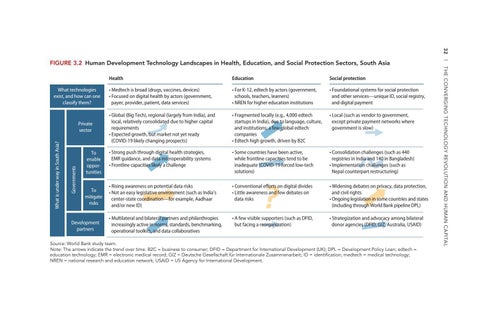What technologies exist, and how can one classify them?
Governments
What is under way in South Asia?
Private sector
To enable opportunities To mitigate risks
Development partners
Health
Education
Social protection
• Medtech is broad (drugs, vaccines, devices) • Focused on digital health by actors (government, payer, provider, patient, data services)
• For K-12, edtech by actors (government, schools, teachers, learners) • NREN for higher education institutions
• Foundational systems for social protection and other services—unique ID, social registry, and digital payment
• Global (Big Tech), regional (largely from India), and local, relatively consolidated due to higher capital requirements • Expected growth, but market not yet ready (COVID-19 likely changing prospects)
• Fragmented locally (e.g., 4,000 edtech startups in India), due to language, culture, and institutions; a few global edtech companies • Edtech high growth, driven by B2C
• Local (such as vendor to government, except private payment networks where government is slow)
• Strong push through digital health strategies, EMR guidance, and data interoperability systems • Frontline capacities likely a challenge
• Some countries have been active, while frontline capacities tend to be inadequate (COVID-19 forced low-tech solutions)
• Consolidation challenges (such as 440 registries in India and 140 in Bangladesh) • Implementation challenges (such as Nepal counterpart restructuring)
• Rising awareness on potential data risks • Not an easy legislative environment (such as India’s center-state coordination—for example, Aadhaar and/or new ID)
• Conventional efforts on digital divides • Little awareness and few debates on data risks
• Widening debates on privacy, data protection, and civil rights • Ongoing legislation in some countries and states (including through World Bank pipeline DPL)
• Multilateral and bilateral partners and philanthropies increasingly active in norms, standards, benchmarking, operational toolkits, and data collaboratives
• A few visible supporters (such as DFID, but facing a reorganization)
• Strategization and advocacy among bilateral donor agencies (DFID, GIZ, Australia, USAID)
Source: World Bank study team. Note: The arrows indicate the trend over time. B2C = business to consumer; DFID = Department for International Development (UK); DPL = Development Policy Loan; edtech = education technology; EMR = electronic medical record; GIZ = Deutsche Gesellschaft für Internationale Zusammenarbeit; ID = identification; medtech = medical technology; NREN = national research and education network; USAID = US Agency for International Development.
32 l THE CONVERGING TECHNOLOGY REVOLUTION AND HUMAN CAPITAL
FIGURE 3.2 Human Development Technology Landscapes in Health, Education, and Social Protection Sectors, South Asia

